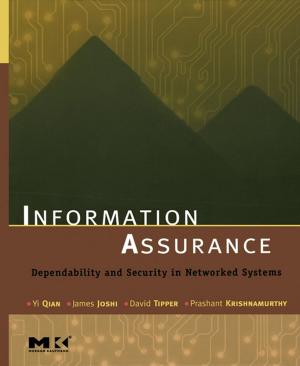Digital Triage Forensics
Processing the Digital Crime Scene
Nonfiction, Computers, Networking & Communications, Computer Security, Operating Systems, Application Software| Author: | Stephen Pearson, Richard Watson | ISBN: | 9781597495974 |
| Publisher: | Elsevier Science | Publication: | July 13, 2010 |
| Imprint: | Syngress | Language: | English |
| Author: | Stephen Pearson, Richard Watson |
| ISBN: | 9781597495974 |
| Publisher: | Elsevier Science |
| Publication: | July 13, 2010 |
| Imprint: | Syngress |
| Language: | English |
Digital Triage Forensics: Processing the Digital Crime Scene provides the tools, training, and techniques in Digital Triage Forensics (DTF), a procedural model for the investigation of digital crime scenes including both traditional crime scenes and the more complex battlefield crime scenes. The DTF is used by the U.S. Army and other traditional police agencies for current digital forensic applications. The tools, training, and techniques from this practice are being brought to the public in this book for the first time. Now corporations, law enforcement, and consultants can benefit from the unique perspectives of the experts who coined Digital Triage Forensics. The text covers the collection of digital media and data from cellular devices and SIM cards. It also presents outlines of pre- and post- blast investigations.
This book is divided into six chapters that present an overview of the age of warfare, key concepts of digital triage and battlefield forensics, and methods of conducting pre/post-blast investigations. The first chapter considers how improvised explosive devices (IEDs) have changed from basic booby traps to the primary attack method of the insurgents in Iraq and Afghanistan. It also covers the emergence of a sustainable vehicle for prosecuting enemy combatants under the Rule of Law in Iraq as U.S. airmen, marines, sailors, and soldiers perform roles outside their normal military duties and responsibilities. The remaining chapters detail the benefits of DTF model, the roles and responsibilities of the weapons intelligence team (WIT), and the challenges and issues of collecting digital media in battlefield situations. Moreover, data collection and processing as well as debates on the changing role of digital forensics investigators are explored.
This book will be helpful to forensic scientists, investigators, and military personnel, as well as to students and beginners in forensics.
- Includes coverage on collecting digital media
- Outlines pre- and post-blast investigations
- Features content on collecting data from cellular devices and SIM cards
Digital Triage Forensics: Processing the Digital Crime Scene provides the tools, training, and techniques in Digital Triage Forensics (DTF), a procedural model for the investigation of digital crime scenes including both traditional crime scenes and the more complex battlefield crime scenes. The DTF is used by the U.S. Army and other traditional police agencies for current digital forensic applications. The tools, training, and techniques from this practice are being brought to the public in this book for the first time. Now corporations, law enforcement, and consultants can benefit from the unique perspectives of the experts who coined Digital Triage Forensics. The text covers the collection of digital media and data from cellular devices and SIM cards. It also presents outlines of pre- and post- blast investigations.
This book is divided into six chapters that present an overview of the age of warfare, key concepts of digital triage and battlefield forensics, and methods of conducting pre/post-blast investigations. The first chapter considers how improvised explosive devices (IEDs) have changed from basic booby traps to the primary attack method of the insurgents in Iraq and Afghanistan. It also covers the emergence of a sustainable vehicle for prosecuting enemy combatants under the Rule of Law in Iraq as U.S. airmen, marines, sailors, and soldiers perform roles outside their normal military duties and responsibilities. The remaining chapters detail the benefits of DTF model, the roles and responsibilities of the weapons intelligence team (WIT), and the challenges and issues of collecting digital media in battlefield situations. Moreover, data collection and processing as well as debates on the changing role of digital forensics investigators are explored.
This book will be helpful to forensic scientists, investigators, and military personnel, as well as to students and beginners in forensics.
- Includes coverage on collecting digital media
- Outlines pre- and post-blast investigations
- Features content on collecting data from cellular devices and SIM cards















